
Eddington is the lava-flooded remnant of a lunar impact crater, located on the western part of Oceanus Procellarum. The western rim is attached to the wall of the walled plain Struve. To the east-southeast is the smaller but prominent crater Seleucus. South of Eddington is Krafft.
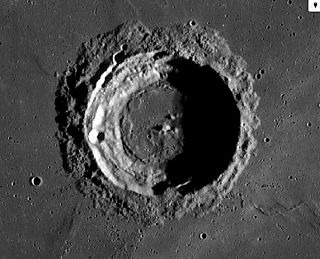
Seleucus is a lunar impact crater located in the western part of Oceanus Procellarum. To the west is the lava-flooded remains of the walled plain Eddington. To the southwest is the crater Krafft and to the northwest lies Briggs.
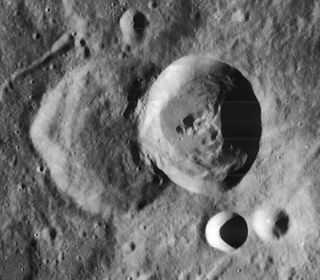
Sirsalis is a relatively young lunar impact crater located near the western lunar limb, to the southwest of the Oceanus Procellarum. The crater lies across a ridge that runs in a north–south direction. It has a sharp edge and a low central peak. The crater overlaps the slightly larger and older Sirsalis A to the west-southwest, and the two form a distinctive feature.

Grimaldi is a large basin located near the western limb of the Moon. It lies to the southwest of the Oceanus Procellarum, and southeast of the crater Riccioli. Between Oceanus Procellarum is Damoiseau, and to the north is Lohrmann.
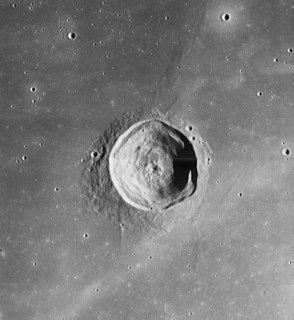
Schiaparelli is a lunar impact crater located on the western part of the Oceanus Procellarum, to the west of the crater Herodotus. The rim is relatively sharp-edged and relatively free from impact wear. The inner walls have slumped to form a shelf around much of the sides. The interior floor is somewhat irregular, but free from impacts of note.

Hevelius is a low-rimmed lunar impact crater that lies at the western edge of the Oceanus Procellarum, named after the astronomer Johannes Hevelius. The smaller but prominent crater Cavalerius is joined to the northern rim by low ridges. Due south of Hevelius is the crater Lohrmann and the dark-hued Grimaldi.

Cardanus is a lunar impact crater that is located in the western part of the Moon, in the western part of the Oceanus Procellarum. Due to its location the crater appears very oval because of foreshortening, and it is viewed almost from the side.
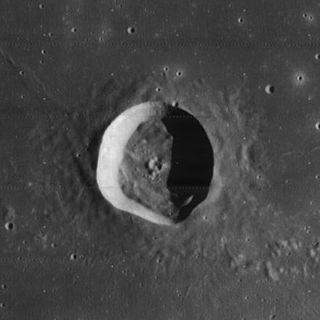
Flamsteed is a small lunar impact crater located on the Oceanus Procellarum, which is named after British astronomer John Flamsteed. It lies almost due east of the dark-hued Grimaldi, and north-northwest of the flooded Letronne bay on the south edge of the mare.

Reiner is a lunar impact crater on the Oceanus Procellarum, in the western part of the Moon. It has a nearly circular rim, but appears oval in shape due to foreshortening. The rim edge is well-defined and has not been eroded by impacts. In the midpoint of the irregular crater floor is a central peak. Outside the rim is a hummocky rampart that extends out across the mare for about half a crater diameter.

Gruithuisen is a lunar impact crater that lies on the section of lunar mare that joins Oceanus Procellarum in the west to Mare Imbrium in the east. Southeast of Gruithuisen is the small crater Delisle. To the south is Dorsum Bucher, a wrinkle ridge running in a north–south direction for about 90 kilometers.
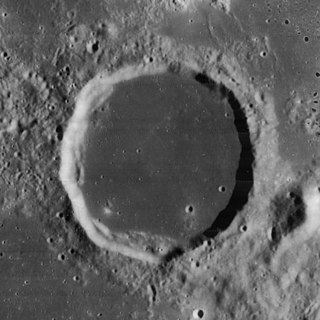
Billy is a lunar impact crater that is located at the southern fringes of the Oceanus Procellarum, in the western hemisphere of the Moon. It was named after French mathematician Jacques de Billy. It lies to the southeast of the similar-sized crater Hansteen, and west-southwest of the flooded Letronne.

Bunsen is a lunar impact crater that lies near the northwestern limb of the Moon. It is located to the west of the Oceanus Procellarum and the crater von Braun. To the southeast is the crater Lavoisier, and to the northeast lies Gerard. Northwest of Bunsen, on the far side of the Moon, is McLaughlin. Due to its position this crater appears foreshortened when viewed from the Earth, and its visibility is affected by libration.
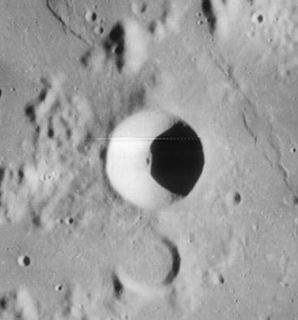
Darney is a small lunar impact crater that is located on the region of the Moon where the Mare Nubium joins the Oceanus Procellarum. It was named after French astronomer Maurice Darney. To the south is the lava-flooded crater Lubiniezky. The southern rim of Darney is attached to a series of low ridges that extend to the southwest.

Hermann is a small lunar impact crater that is located in the western Oceanus Procellarum, just over one crater diameter to the south of the Moon's equator. It is a solitary crater with only a few tiny craterlets and some low wrinkle ridges nearby.

Damoiseau is a lunar impact crater that is located just to the west of the Oceanus Procellarum, in the western part of the Moon's near side. It lies due east of the prominent crater Grimaldi, a walled plain with a distinctive dark floor. Due south of Damoiseau is the crater Sirsalis.

Harding is a small lunar impact crater that lies in the Sinus Roris, a bay in the northwest part of the Oceanus Procellarum. Because of its location near the northwest limb of the Moon's near side, this crater is viewed at a relatively low angle from the Earth resulting in foreshortening and limiting the amount of detail that can be seen.
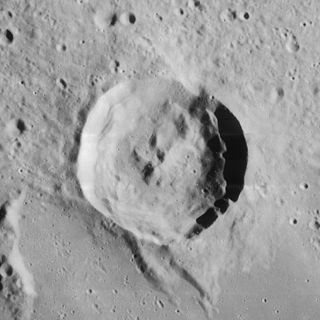
Markov is a lunar impact crater that is located in the northwestern part of the moon’s near side, in the Sinus Roris region of the Oceanus Procellarum. It lies to the south of the crater Oenopides, and is connected to the continental region to the north by ridges along the northern rim.
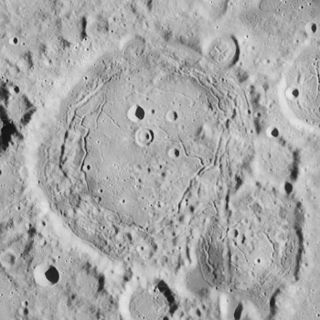
Lavoisier is a lunar impact crater that is located near the northwestern limb of the Moon, at the western edge of the Oceanus Procellarum. It is named after the French chemist Antoine Lavoisier. It is located to the southwest of the crater von Braun and southeast of Bunsen. Due south of Lavoisier is the disintegrated crater Ulugh Beigh.

Voskresenskiy is a lunar impact crater that is located near the western limb of the Moon. Due to its position, this crater is viewed edge-on, limiting the amount of detail that can be viewed. The visibility of this formation is also affected by libration, so that at times this crater is hidden from sight, while at other times it can be more readily viewed.
Fontana is a lunar impact crater that is located in the southwestern part of the Moon's near side, to the south of the Oceanus Procellarum. It lies to the west-northwest of the flooded crater Zupus. Midway between Fontana and Zupus is a rille system designated Rimae Zupus.






















